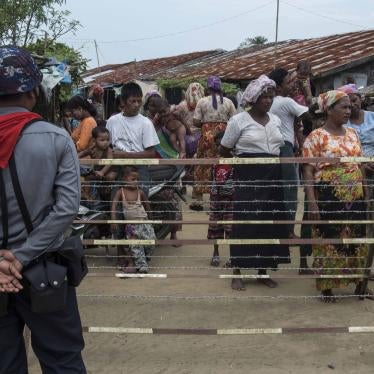This “has to be an isolated case.” So claims a spokesman at Burma’s foreign ministry about a disturbing video that emerged this weekend showing police officers brutally beating ethnic Rohingya villagers, including some who appeared to be children, in northern Rakhine State.
Unlike the Burmese government’s usual indignant denials that state security forces are committing abuses against the marginalized Rohingya population, the leaked video has prompted the government to admit that in this case police officers had abused villagers during “clearance operations.” The video, filmed by a police officer, shows police officers kicking villagers and beating one man repeatedly with what appears to be a baton. The government said that “legal action is being taken” against six officers whom it says were involved.
Yet when it comes to allegations of other serious abuses, the government remains curiously intransigent. The claim by the foreign ministry, which is headed by Burmese leader Aung San Suu Kyi, that this was an isolated case rings hollow.
While the government’s swift response to these allegations is important, numerous other rights abuses, including extrajudicial killings, rape, and the destruction of villages await proper investigation and appropriate prosecution. Ultimately this case may be yet another attempt to keep the lid on crimes being committed by security forces in locked-down northern Rakhine State.
Early last month, we listened to Rohingya refugees in Bangladesh who fled Rakhine State’s Maungdaw Township recount atrocities perpetrated by the Burmese military against Rohingya villagers. Rohima, 50, relived the horrors she witnessed: “I saw they tortured, killed, slaughtered the men and the women. And raped the women and young girls.”
But so far, the government has roundly rejected the growing reports of serious abuses, even calling some of them “fake rapes.”
Since the current spate of violence erupted after Rohingya militants attacked Border Guard Police posts in early October 2016, killing nine security personnel, Human Rights Watch has used satellite imagery to identify at least 1,500 buildings that were destroyed in Maungdaw Township between October and November last year. The pattern of destruction strongly suggests that the buildings were destroyed in arson attacks that were part of a military operation. Witnesses to the destruction also say the military was responsible.
Two separate government investigations have either dismissed the allegations against the military entirely or failed to address them, claiming there is insufficient evidence. Instead, the government claims without evidence that the Rohingya militants were responsible for the widespread burnings.
Since the violence erupted, the government has prevented both humanitarian groups from providing much-needed assistance, and human rights researchers and journalists from independently conducting on-the-ground investigations.
Faced with overwhelming video evidence, Burma’s government has acted swiftly. But the video begs the question: If police officers unashamedly film themselves savagely beating Rohingya villagers, what horrors are taking place off camera?










